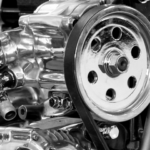Aligning decarbonization, circularity and competitiveness in Europe’s automotive industry




In January 2025, the EU Commission President Ursula von der Leyen launched a Strategic Dialogue on the Future of the European Automotive Industry 1https://ec.europa.eu/commission/presscorner/detail/en/ip_25_378to address the sector’s urgent challenges and strengthen its competitiveness in a rapidly evolving global market. This initiative aims to develop a comprehensive Action Plan by 5 March. It comes at a critical time, as the decarbonization of road transportation needed to meet the EU Green Deal’s objectives requires leveraging all available tools, including the electrification of cars and trucks, sufficiency, modal shifts, reducing vehicle production footprints, enhancing material circularity, and improving end-of-life management. The key is to tackle local resilience and circularity objectives simultaneously instead of choosing one over the other.
Making circularity a pillar of industrial competitiveness
The recently launched EU Clean Industrial Deal (CID) emphasizes that achieving these goals necessitates prioritizing materials circularity. Circularity reduces the carbon and material footprints of new vehicles, lessens resource pressure (limiting primary raw material extraction), and enhances EU autonomy over strategic or critical materials. High-quality, closed-loop recycling must become a priority, requiring regulatory frameworks that promote investment in qualitative recycling infrastructure. The objective is to transform the downcycling industry developed over the past three decades–primarily focused on waste elimination services–into a high-value resource industry that supplies the European manufacturing industry, fostering competitiveness and autonomy.
The EU’s Circular Economy Action Plan (2020) laid the foundation for resource efficiency and sufficiency, which has since been translated into sector-specific regulations. The EU Battery Regulation, for example, mandates that new batteries contain at least 6% recycled lithium and nickel, and 16% recycled cobalt by 2031.
Building on this momentum, the CID sets a goal for the EU to lead in circular economy practices by 2030 and identifies circularity and access to materials as key business drivers for a thriving EU industrial ecosystem. To achieve this, the upcoming Circular Economy Act (Q4 2026) will establish a single market for waste and secondary raw materials. Additionally, the proposed regulation on circularity requirements for vehicle design and on management of end-of-life vehicles aims to improve recycling efficiency by integrating eco-design principles, mandatory recycled content targets, and stronger end-of-life management incentives.
Further aligning decarbonization with circularity, the Industrial Decarbonization Accelerator Act (Q4 2025) is expected to introduce minimum local content requirements and a voluntary carbon intensity label for industrial products, starting with steel in 2025. Member States are expected to integrate these measures into fiscal policies, using non-price criteria (such as sustainability standards) for procurement and incentives on relevant products such as low-carbon steel and sustainable batteries.
Overall, circularity is central to an array of key EU regulations. Although the CID represents a step forward in incentivizing domestic recycling, designing and implementing measures must consider potential rebound effects or circumvention risks.
Aligning circularity and competitiveness
Building a robust closed-loop recycling industry in Europe requires ambitious reincorporation targets for recycled materials, supported by three key policy pillars: local content requirements, regulatory incentives, investment-driven demand stimulation. Encouraging product repairability and waste export limitations are two complementary levers to be considered for a consistent regulatory landscape that secures business opportunities in Europe.
1. Establishing a local content principle for recycled content
In order to ensure Europe retains the value of its recycled materials, new policy tools, such as EU-made labels and local content mandates, must be integrated into existing and upcoming regulations. This would make the use of ‘Made in Europe’ recycled materials a prerequisite for compliance with circular economy rules.
For example, the steel recycling value chain must tackle copper contamination in end-of-life vehicle recovery, as it prevents the production of high-quality flat steel from scrap. Electric Arc Furnaces (EAFs) which are central to decarbonized steel plants (DRI-EAFs), have a higher capacity to absorb recycled steel but are limited by copper pollution. Therefore, increasing the availability of low-copper-content steel scrap is essential to maximize the use of EAFs and ultimately enhance the economic viability of end-of-life vehicle recycling.
Similarly, the EU Battery Regulation’s reincorporation targets mark a major step forward. However, regulations should go further by requiring that recycled materials be sourced within Europe to:
- Strengthen demand for European recycling facilities;
- Prevent downcycling and retain material value;
- Secure investment and de-risk recycling businesses.
Additional measures, such as black mass export limitations, would complement this policy framework by ensuring valuable battery materials remain within the regional supply chain. Furthermore, it would prevent situations where materials are shipped abroad for lower-cost processing, often under weaker environmental and labour standards. By keeping valuable secondary raw materials within Europe, these measures not only strengthen the EU’s recycling industry but also prevent the export of environmental and social costs of waste management to other regions, ultimately supporting more sustainable global resource use.
2. Incentivizing circularity and decarbonization
A Local or Green Content Scoring Index could transform circularity into a competitive advantage for EU suppliers. This index would be integrated into:
- Regulatory frameworks (e.g., Battery Regulation, Eco-Design Directive);
- Public procurement and fiscal incentives (e.g., tax incentives, fleet EV mandates);
- Investment mechanisms (e.g., European Investment Bank (EIB) loans, Innovation Fund, state aid).
Key metrics would include:
- A Decarbonization Index, assessing the carbon footprint of materials (steel, aluminium, plastics, batteries);
- A Circularity Index, prioritizing EU-produced recycled content, integrating ‘Made in EU’ materials into vehicle and battery regultions.
These indicators would provide European manufacturers with preferential access to local recycled materials and strengthen their position in compliance-driven markets.
Furthermore, these indicators could be introduced in corporate fleet EV mandates to reward vehicles containing higher EU-made recycled content by assigning weighted compliance scores (e.g., a locally sourced electric vehicle could count as 1.2 vehicle in green fleet quotas, while a non-EU vehicle would count as 0.9).
3. Securing investment through demand stimulation
Incentivizing local content requirements can be accelerated by leveraging the Decarbonization and Circularity Indexes or Scoring in national tax policies and public procurement strategies. For instance, the French electric vehicle bonus, currently based on eco-scores, could expand to include local content factors, ensuring Europe captures the green premium.
Additionally, EU financing programs such as EIB loans, the Innovation Fund, and state aid mechanisms should prioritize investments in European recycling infrastructure, ensuring long-term growth in the sector.
4. Beyond recycling: a Repairability Index
Beyond material circularity, repairability is another crucial aspect to favour EU-produced components. Encouraging vehicle designs that enhance repairability and longevity can support sustainability goals while creating economic opportunities for EU-based component manufacturers. A Repairability Index could support regulatory incentives that drive the production of long-lasting, easily repairable components within Europe.
Conclusion
By aligning local content requirements, regulatory incentives, and investment-driven demand stimulation, the EU can strengthen its recycling industry, secure supply chains, and enhance competitiveness. This policy framework would not only reduce reliance on virgin raw materials but also ensure Europe retains the economic and strategic value of its recycled resources, along with its sovereignty, sustainability and industrial resilience.
- 1https://ec.europa.eu/commission/presscorner/detail/en/ip_25_378